DECEMBER 05, 2022
By Francis Lee
During the Second World War in Europe, particularly in the East, special corps of mobile German extermination units known as “Einsatzgruppen” (literally “operational groups”) were recorded has having exterminated well over one million civilians, primarily in mass shootings in the greater Soviet Union and also included the Baltics, Romania, and Poland.
Whenever Nazi Germany’s army marched East it immediately occupied and ethnically cleansed and secured the newly seized territories. Their principal tasks were to identify and neutralize potential enemies to German rule, seizing important sites, preventing sabotage, recruiting collaborators, and establishing intelligence networks. The Einsatzgruppen – see the glossary below – was principally charged with this grisly task. They also killed some ‘unreliable’ civilians who were perceived as their enemies. Together with Einsatzgruppen various other units included the Waffen SS, Order Police, and local collaborators who ‘liquidated’ thousands of Jews and tens of thousands of members of the Polish elites.
With the start of Hitler’s “war of annihilation” against the Soviet Union in June 1941, the scale of Einsatzgruppen mass murder operations vastly increased. The main targets were the Communist Party and Soviet state officials, Roma, and above all Jews of any age or gender. Under the cover of war and using the pretext of military necessity, the Einsatzgruppen viewed this term in the glossary organized and helped to carry out the shooting of more than half a million people, the vast majority of them Jews, in the first nine months of the war.
The 3,000 personnel of all four Einsatzgruppen groups viewed this term in the glossary and did not conduct these killings alone. Units of the Waffen SS, Order Police, Wehrmacht, allied Romanian forces and local collaborators willingly gave them aid and succour. The latter collaborators helped to identify victims as well as kill them. Many of the killers and victims actually knew one another as neighbours and colleagues. For example, over two days in September 1941, a small detachment of Einsatzgruppe C along with larger units of Waffen SS, Order Police and Ukrainian auxiliaries conducted a mass shooting of Jews in Babyn Yar (Babi Yar), a ravine outside Kyiv (Kiev). According to reports sent to the Einsatzgruppen headquarters in Berlin, 33,771 Jews were massacred during this two-day period. When occupied territories came under civilian control, stationary offices of the SS and Police replaced the Einsatzgruppen and continued to conduct mass shootings.
One particular case involved a family caught up in the general chaos. The daughter – a girl named, Frima – and her family were confined in a Jewish ghetto; in which the Nazis used her father as an interpreter. He later perished. By pretending not to be Jews, Frima, her mother, and sister escaped a German mobile killing unit massacre. They were later discovered and jailed. Again, her mother devised an escape. Frima’s mother and sister were smuggled to Romania, while Frima wandered in search of safekeeping until her mother could arrange to smuggle her out. In Romania, they were reunited and liberated. As cited in the United States – see below.
US Holocaust Memorial Museum Collection. Author(s): United States Washington, DC
Often referred to as an Aktion, a massacre typically began when Jews and other victims were rounded up or ordered to report to a central destination. The victims were then marched or transported to the killing site. If a mass grave had not already been dug, the victims were forced to dig one. They were stripped of clothes and valuables and driven in groups to the pit. The Einsatzgruppen view this term in the glossary and their assistants either shot the victims at the edge so that they fell in or forced them into the grave to be shot. Friends and families often had to watch their loved ones die before them.
The mass shootings were resource-intensive, requiring many shooters and escort guards as well as guns, ammunition, and transport. Concerns about the inefficiency of the shootings and their psychological impact on the shooters led to the development of special vans outfitted with engines that pumped carbon monoxide into sealed passenger compartments. Jews were packed into the compartments, then driven to a mass grave, and asphyxiated during the journey. It took much longer to kill very large groups of victims with the gas vans, however. The Einsatzgruppen view this term in the glossary where personnel were required to remove bodies and clean the compartments. Throughout the German occupation of seized Soviet territories, mass shootings continued to be the preferred method of murdering Jews. At least 1.5 million and possibly more than 2 million Holocaust victims died in mass shootings or gas vans in Soviet territory.
Latvia?
Barbaric as the German atrocities were, they were to be aided and abetted by elements of the local indigenous populations. Particularly in the Baltics and Ukraine.
‘’They say that time is a great healer, but to the Jewish community in Latvia, the events of 1941 will never be forgotten. As many as 70,000 were murdered, and the Museum “Jews in Latvia” commemorates this terrible time in Latvian history. But the Museum does more than this and tells the story of the Jewish Community from its inception to the present day.’’ (Phillip Houseley – 2018).
Lithuania?
‘’Almost all Jews living in Lithuania were annihilated from 1941 until 1944, but there is a reluctance among Lithuanians to discuss the collaboration with the Nazis that enabled slaughter on such a massive scale. Participation – mainly by the Lithuanian police in Holocaust crimes – is acknowledged to have occurred but does not attract the attention it warrants. More references are made to the few locals who saved Jews and can be numbered among the righteous among the nations than to the vastly larger number of Lithuanians who collaborated with the Nazis. Collaborators are largely perceived as “victims” in the national discourse.’’
Bar-Ilana University (Begin-Sadat Centre for Strategic Studies)
Estonia
The Jewish community was amongst the first to be rounded up in accordance with the General plan Ost (East) which required the removal of 50% of Estonian citizens. With the invasion of the Baltics, it was the intention of the Nazi government to use the Baltic countries as their main area of mass genocide.
Consequently, Jews from countries outside the Baltics were shipped there to be exterminated. Out of the approximately 4,300 Jews in Estonia before the war, between 950 and 1,000 were entrapped by the Nazis. An estimated 10,000 Jews were killed in Estonia after having been deported to camps there from elsewhere in Eastern Europe. There have been 7 known ethnic Estonians—Ralf Gerrets, Ain-Ervin Mere Jaan Viik, Juhan Jüriste, Karl Linnas, Aleksander Laak, and Ervin Viks—who have faced trials for crimes against humanity. Since the reestablishment of Estonian independence, the Estonian International Commission for Investigation of Crimes Against Humanity has been established. Markers were put in place for the 60th anniversary of the mass executions that were carried out at the Lagedi, Vaivara and Klooga (Kalevi-Liva) camps in September 1944.
Ukraine
The Dynamic Duo:
Stepan Bandera (1909-1959) Statue in Ternopil
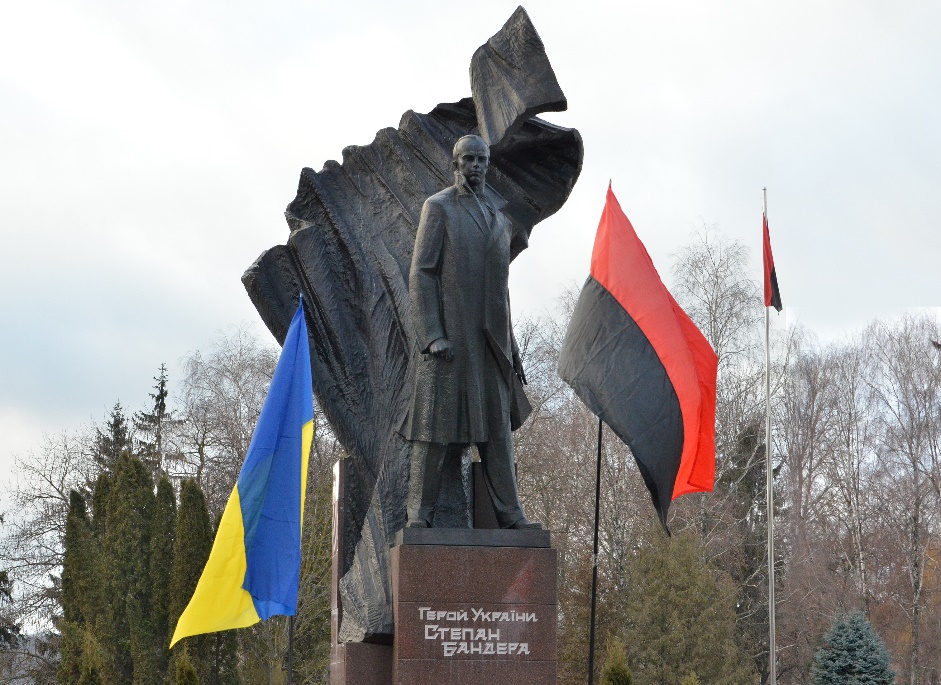
Leader of the (OUN-B) Bandera remains even today a highly controversial figure in Ukraine, with many Ukrainians principally in the West of the country – hailing him as a role model hero, martyred liberation fighter, whilst other Ukrainians, particularly in the south and east of the Dnieper condemn him as a fascist, Nazi collaborator who was, together with his followers, responsible for the large-scale massacres of up to 100,000 Polish, Jewish and Russian civilians in western Ukraine in 1943-44. Bandera was assassinated by a KGB hit-man in Munich in 1959.
Looking back the name Bandera initially became synonymous with Ukrainian nationalism during the Soviet era. Stephan Bandera was born in 1909 in the town of Trostianec, near Stryj. His father was a Greek Catholic priest. He attended elementary school in Sokal and high school in Stryj. While still in high school he became a member of UVO, the veterans’ organization of Ukrainian nationalists from the First World War. He became commander of the OUN for Western Ukraine, and Poland. There is little doubt that Stefan Bandera was an extreme rightist in his political outlook. In 1934, he and confederate Mikola Lebed planned and organized the assassination of Pieracky, the Polish Minister of the Interior, accused by the Ukrainians of anti-Ukrainian acts. He was first sentenced to death and then the sentence was commuted to life imprisonment. His trial took place in 1935 after which he was committed to the Holy Cross jail where he remained until 1939. It is alleged that his sentence was commuted to avoid an uprising of Ukrainian nationalists in Eastern Poland and the Ukraine.
The circumstances surrounding Bandera’s escape or release from Polish prison in 1939 are not clearly known. Once free, Bandera resumed his leadership of OUN in the homeland. After the invasion of Poland (1939), the OUN collaborated with Germany against the Poles and, later, against the Soviet Union.
In early summer 1940 the OUN split, and Bandera became the overall chief of the greater part of the organization. For some time, the OUN was composed of two factions, both claiming the name. The dissident group, comprising about 80 percent of the organization, was called OUN-Bandera [OUN(B)] or the Bandera group. The larger faction OUN-B was headed by Stefan Bandera and the smaller faction OUN-M (headed by Andre Melnik. Both OUN factions created their own special forces units, named “Rolland” and “Nachtigall.”
Realizing that the aspiration for national independence was uppermost in the minds of a majority of Ukrainians, the Third Reich promised at the beginning of World War II that the Ukrainians would be freed from Soviet domination and could found a Ukrainian state. When the Germans attacked Russia, many members of the OUN followed the Germans’ advance eastward. Bandera remained in Cracow.
A “Ukrainian State” was founded by Bandera on 10 June 1941. The proclamation of the “state” took place in an atmosphere of great solemnity, with Hitler’s representatives participating. The German occupation forces at the time needed agents and informers who were conversant with conditions in Poland and could help the Hitlerite invaders. They could find no better men for the job than Bandera and his followers. Bandera launched the campaign which was to make him master of the OUN. To achieve this, he found it necessary, first, to compromise the old leadership headed by Melnyk. A simple denunciation to the Gestapo was sufficient to cause persons objectionable to Bandera to be arrested and liquidated at his order.
Over 25,000 Poles, Jews and Russians were destroyed in a single operation at the border of the Carpathian Ukraine. The Hungarian gendarmes drove these Jews out from the area which had been occupied by Hungary with Hitler’s consent. At the border, they were received by “special” elements of the Bandera militia, which drove them to unknown parts, destroying all of them en route. Altogether, during the 5 weeks of its existence, the Bandera’s “state” destroyed over 5,000 Ukrainians, 15,000 Jews, and several thousand Poles.
The “Ukrainian State” of Stepan Bandera ended its short but ignominious existence in August 1941, when it was announced in Lvov that Western Ukraine had been incorporated as the “District of Galicia” in the “General Governorship” (occupied Poland).
And when Bandera had done his duty, he and some of his assistants were dispatched to a concentration camp. The Gestapo had its own candidates for the posts of gauleiters and governors of the Ukraine. At any rate, Bandera was taken to Berlin and placed under house arrest there. He was shortly transferred to the Prinz Albrecht Strasse Gestapo jail reserved for important political prisoners. In 1942 Bandera and several other OUN leaders were transferred to the Sachsenhausen concentration camp.
Against the Soviets – 1943-1945
In 1943 the OUN(B) quit the collaboration game and turned on the Germans in an effort to establish an independent Ukraine free of Nazi or Soviet control. The Nazis did not recognize the government created by the part of OUN headed by Stepan Bandera on 10 June 1943. At the beginning of 1943 the OUN(b) started to create UPA (Ukrainian Insurgent Army – led by Roman Shukeyvich (see below) – that started the underground struggle when the Red Army entered the territory of the Western Ukraine. At all stages of UPA existence, the Soviet regime with all its political, military, and security structures (partisan, army, NKVD units, and internal forces), remained the number one enemy of the Ukrainian nationalists.
The population was still resentful for the recent genocidal famine in Ukraine. The war between UPA and Soviet military and security structures coincided in time with the war of the United Nations (including the Soviet Union) against the fascist bloc, although these wars are entirely different by nature and origin.
During the war years, at the time that Bandera was incarcerated in a German concentration camp, there sprang up in the Ukraine a number of fighting units. Some of these units united under the banners of Taras BULBA-BOROVETS, OUN/Melnyk and OUN/Bandera. Since it was apparent to all that there should be a unified command, all three commands tried to unite, but OUN/Bandera, being possibly strongest in number, decided that it should lead all others. It was at this time that there was considerable fratricide committed. Rumour has it that the entire general staff of Tares BULBA-BOROVETS was liquidated by OUN/Bandera, as well as a number of those who backed Colonel Andrew Melnyk – among the latter two OUN/Melnyk leaders, STSIBORSKY and SENYK-HRYBIVSKY.
Roman Shukeyvich (1907-1959)
The controversial (sic!) Ukrainian national hero (sic!). The statue below was a monument to Roman Shukhevych military Commander in Chief to the Ukrainian Insurgent Army (UPA), Stepan Bandera, however, was the political wing of the movement the Organization of Ukrainian Nationalists (OUN-B) who along with Bandera was assassinated by unknown, possibly Soviet assassins.
Shukeyvich’s statue has stood at the entrance of the Ukrainian Youth Unity Complex in North Edmonton, Alberta, Canada, since the mid-1970s. Shukhevych is lionized by some for his fight for Ukrainian independence against Poland, the Soviet Union and later Germany. But critics of the monument say it glorifies a Nazi henchman who sided with Germany in hopes of winning independence for Ukraine.
The Ukrianian diaspora is still in evidence and in high places in the Ukraine. Canadian Foreign Secretary, Christiya Freeland is a prominent critic of Russia who was banned from the country in 2014. She happens also to be a friend of Victoria Nuland, and both are passionate supporters of her coup in Ukraine. Ms Freeland is co-chair of the Lima Group which is apparently dedicated to the overthrow of Venezuela’s President Nicolás Maduro.
In the somewhat murky political background of Ms Freeland, she had long since been an advocate of militant Ukrainian nationalism; this followed very much in the family tradition. Some interesting facts dug out by some Polish and Australian journalists investigating past and present Ukrainian threats to Polish sovereignty in Galicia-Ukraine. “This Canadian statement is discreditable, not only for its ignorance of the ‘surprises’ in the Polish and German records of World War II. It’s also a declaration of comfortable complacency in not investigating how much Freeland aims to revive the takeover of Polish Galicia, with Canadian money and arms, which her Nazi grandfather tried with German money and arms.”
See Further: German military records have been found in a Polish government archive in Warsaw revealing that, Michael Chomiak maternal grandfather of Canadian Foreign Minister Chrystia Freeland, volunteered to serve in the German invasion of Poland long before the German Army attacked the Soviet Union and invaded Ukraine.’’
John Helmer
The German Army (Officers) reaches Ukraine 1941. They seem to have been welcomed by most of the local population in Vinnitsiya, Ukraine.
There is a whole gallery of gruesome pictures of native populations in Eastern Europe, the worst being carried out by local militias. See below, the ‘last Jew in Vinnytsia’ Ukraine murdered by the local Ukrianian militia.
See Rare Historical Photographs
The above picture is not untypical. There were worse, but for the sake of decency and the deceased’s family I declined to publish them.
Filed under: East Eurpoe, Europe, Hitler, Poland, Ukraine, USSR | Tagged: Baltic republics, Einsatzgruppen mass murder operations, Estonia, Latvia, Lithuania, Nazi Germany, Romania, Stepan Bandera, Victoria Nuland, WWII |
Related posts:
Views: 0
 RSS Feed
RSS Feed

















 December 8th, 2022
December 8th, 2022  Awake Goy
Awake Goy 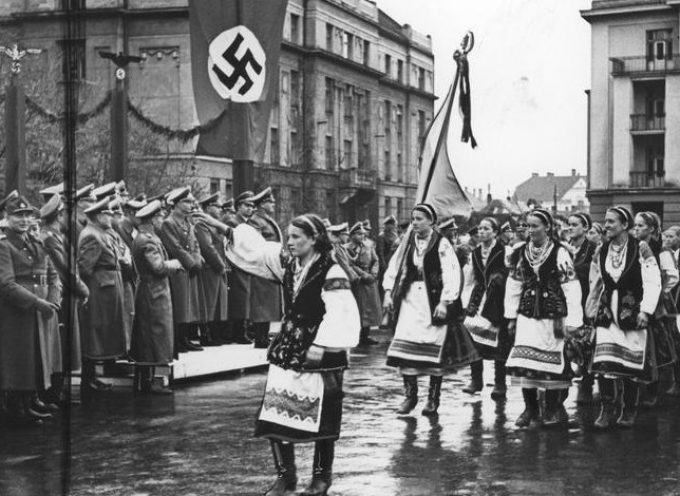
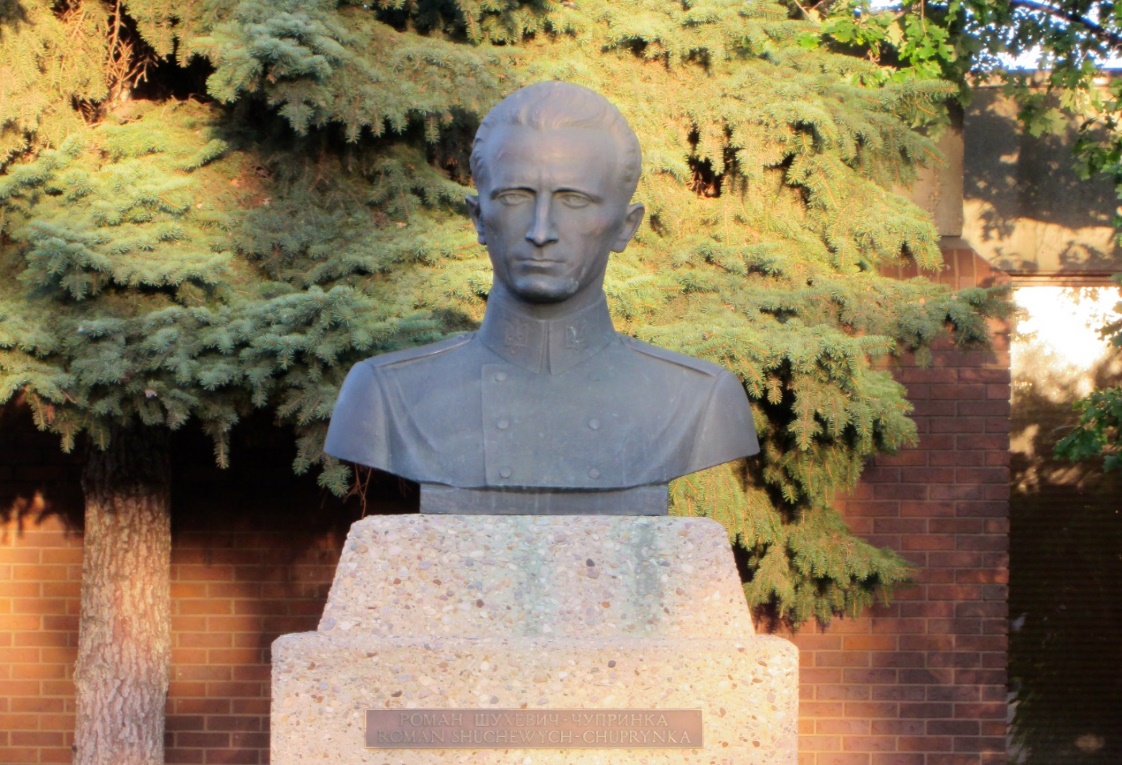



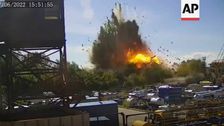

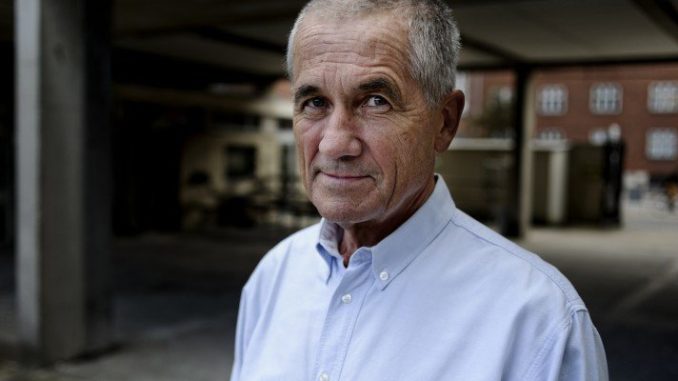
 Posted in
Posted in  Tags:
Tags: 
















